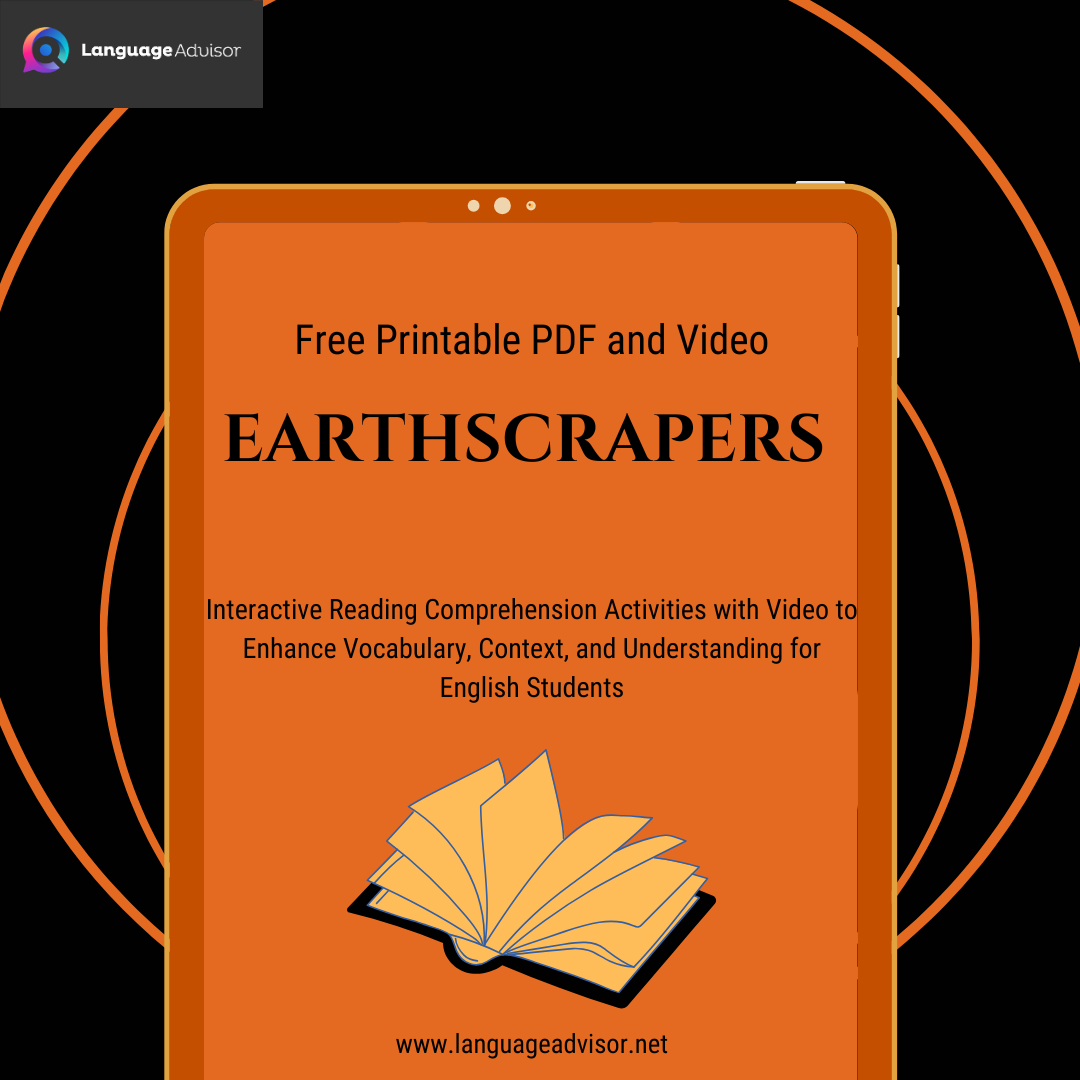Earthscrapers. Interactive Reading Comprehension Activities with Video to Enhance Vocabulary, Context, and Understanding for English Students. Free Printable PDF and Video
Earthscrapers

Improving reading comprehension is a vital skill for English learners at all levels. It goes beyond just understanding the words on the page, but also involves grasping meaning, context, and intent behind a text. One effective way to enhance reading comprehension is by integrating videos alongside written exercises. Video content can provide visual cues, context, and engagement that help reinforce the learning process. In this blog post, we’ll explore a fun and interactive reading comprehension activity that combines written passages with video resources to deepen understanding and make learning more enjoyable.

Earthscrapers – Reading Comprehension

WHILE “skyscraper” is an extremely well-known term, and many people were made aware of “groundscrapers” by Google – who popularised the concept with plans for their new London headquarters – there is another term that is less well-known: “earthscrapers”.
In our groundscrapers video we stated that these long, ground-hugging buildings were the opposite of skyscrapers. But as one of our viewers pointed out in the comments: “surely the opposite of a skyscraper would be an underground building?”
In fact there is a name for a building that extends from the surface, deep underground. These inverted skyscrapers are known as “earthscrapers”.
WHAT DEFINES AN EARTHSCRAPER?
While countless structures are buried underground, such as car parks, arenas and laboratories these are not earthscrapers.
Earthscrapers are best described as an inverted skyscraper. They start at ground level and then extend a considerable distance downwards from the surface.
Although an extremely interesting concept, at present earthscrapers only exist as design concepts, either in fiction or architectural proposals. None have yet been built, as far as we are aware.
EARTHSCRAPER PROPOSALS
The best-known proposal to actually build an earthscraper was an entry to the Evolo Skyscraper Competition in 2012 by Mexican architectural practice BNKR Arquitectur.
Their proposal imagines a 65-storey deep earthscraper placed beneath Mexico City’s central square, the Zócalo.
Plunging 1,000 feet into the earth (around 300 metres), the inverted pyramid is intended to contain a 10-floor museum, 10 storeys housing and 10 storeys of retail units, all above 35 storeys of subterranean office space.
Left: BNKR Arquitectur’s proposal envisages a 65-storey deep earthscraper beneath Mexico.
All of these habitable spaces are arranged around a central void that allows light and ventilation into the structure. This vast hole would be covered with a glazed roof, acting as a floor surface in the square above.
According to BNKR Arquitectur the ambitious plan is a solution that responds to Mexico City’s height regulations limiting new structures to eight storeys in the historic centre, and a huge demand for centrally located property.
However, there are many structural, logistical and regulatory barriers for the project to overcome, and for the time being this earthscraper does not look like being built.
Along with this Mexican example there are several historical examples of earthscrapers, the most notable being one which was featured in a 1931 issue of Popular Mechanics.
Described then as a “depthscraper”, the cylindrical tower made from a steel frame and “armored concrete”, was proposed to extend 35-storeys into the ground.
In this case the motivation for the structure was to provide a residential engineering solution for surviving earthquakes in Japan.
Whilst there are no earthscrapers at present, the continued growth of our cities is placing pressure on central urban areas and driving a number of innovative proposals (such as “micro apartments“). In such context, it’s not a leap to imagine these remarkable structures becoming a reality one day soon.
Watch the video
Reading Comprehension: Earthscrapers
Questions:
What is an earthscraper?
a) A building that extends deep underground
b) A building that stretches across the ground
c) A tall building above ground
d) A car park structure
What inspired the concept of earthscrapers?
a) The need for earthquake-resistant buildings
b) Regulations limiting building heights in urban centers
c) A lack of materials to build skyscrapers
d) A desire to mimic ancient pyramids
What problem does the Mexican earthscraper proposal aim to solve?
a) Increasing housing demand in Mexico City’s central square
b) Lack of tall buildings in the area
c) The need for more parking spaces
d) Protecting against floods in urban areas
How would the central void in the earthscraper help the building?
a) By collecting rainwater
b) By providing ventilation and natural light
c) By preventing earthquakes
d) By creating more space for offices
Why haven’t earthscrapers been built yet?
a) There is no need for underground buildings
b) They are too expensive
c) There are structural, logistical, and regulatory barriers
d) People prefer traditional skyscrapers
True or False:
- The first earthscraper proposal was made in 2012 by a Mexican architectural firm.
- Earthscrapers are similar to car parks and underground arenas.
- Earthscrapers are considered inverted skyscrapers because they extend downward instead of upward.
- The design of earthscrapers is mostly used in fiction and proposals, not in actual construction.
- The main motivation behind earthscrapers is to create space in overpopulated urban centers.
Short Answer:
- What are the main challenges that earthscraper designs face before becoming a reality?
- Explain how the earthscraper’s design helps manage light and ventilation.
- Why is the concept of earthscrapers gaining attention in cities with dense populations?
This activity helps students practice comprehension, analyzing architectural innovations, and exploring futuristic solutions for urban development.

Using video in reading comprehension activities not only enhances students’ engagement but also aids in building critical language skills such as listening, vocabulary development, and contextual understanding. By incorporating multimedia into traditional reading lessons, teachers can cater to various learning styles and keep students motivated. We encourage you to try out this method and observe how it transforms reading into a more dynamic, interactive experience for your English learners.

DOWNLOAD THE PDF FOR FREE





